Almost All People With Two Copies of This Genetic Variant Develop Signs of Alzheimer’s Disease, Study Finds
The research focused on a variant called APOE4 and largely looked at people of European ancestry—risk levels are different for other groups, the authors say
/https://tf-cmsv2-smithsonianmag-media.s3.amazonaws.com/accounts/headshot/Will-Sullivan-photo.png)
Will Sullivan
Daily Correspondent
:focal(1815x1210:1816x1211)/https://tf-cmsv2-smithsonianmag-media.s3.amazonaws.com/filer_public/e7/0a/e70a08dc-1ec3-4c16-8f62-bccfa20435da/gettyimages-151036433.jpg)
Almost all people with two copies of a genetic variant called APOE4 show signs of Alzheimer’s disease, according to a new study of people predominantly of European ancestry.
The findings suggest that people with two copies of the gene—who are called APOE4 homozygotes—have a distinct genetic form of Alzheimer’s. The research points to a need for targeted prevention strategies, clinical trials and treatments, scientists write in the paper published Monday in the journal Nature Medicine .
Alzheimer’s disease is a brain disorder that erodes memory and cognitive function. It may affect more than six million people in the United States, and it’s the seventh highest cause of death in the country.
Scientists don’t fully understand what leads to the disease. But they have identified a few genetic forms of Alzheimer’s, including an early-onset form caused by mutations in three genes, per the study. Other genetic cases are linked to Down syndrome—about half of people with Down syndrome in their 60s have Alzheimer’s.
A number of genetic variants, including APOE4, have been tied to an increased risk for the disease. But with the new paper, researchers suggest having two copies of the APOE4 variant is more than just a risk factor—it might actually be a cause.
“This reconceptualization that we’re proposing affects not a small minority of people,” lead author Juan Fortea , a neurologist at the Sant Pau Memory Unit in Spain, says to the New York Times ’ Pam Belluck.
People with two copies of APOE4 make up 2 percent of the general population, according to the study. But the findings suggest that around 15 percent of people with Alzheimer’s have two copies of the variant. That means those cases “can be tracked back to a cause, and the cause is in the genes,” Fortea tells Lauran Neergaard of the Associated Press .
Not all researchers agree that people with two copies of APOE4 have a unique type of the disease.
“I do not see anything in this paper to justify the claim that carrying two copies of APOE4 represents some ‘distinct genetic form’ of Alzheimer’s disease,” David Curtis , a geneticist at University College London who did not contribute to the findings, tells the Guardian ’s Nicola Davis. “No matter how many [copies] of APOE4 one carries, the underlying disease processes seem similar across cases of Alzheimer’s disease, suggesting that any effective treatment and prevention strategies, which have yet to be developed, would have broad applicability.”
To reach their conclusion, the researchers looked at data from 3,297 donated brains and 10,039 individuals. They found that 273 brain donors and 519 of the participants carried two copies of the APOE4 variant—and almost all of these people had signs of Alzheimer’s disease.
Compared to people with two copies of APOE3, a variant of the APOE gene that has no effect on Alzheimer’s risk, those with two copies of APOE4 had significantly more biomarkers of the disease after turning 55.
By the age of 65, almost all members of this group had abnormal levels of a protein called amyloid —high amounts of which is tied to Alzheimer’s—in their cerebrospinal fluid, and 75 percent of them showed abnormal amyloid levels in brain scans. Their symptoms also started at an earlier age than others—around 65 years old, on average. Symptom onset occurred in a narrow age range, making it predictable.
The study shows that people with two copies of APOE4 “meet the three main characteristics of genetically determined [Alzheimer’s disease],” the authors write: a high prevalence of the disease among the group, a predictability of symptom onset and predictable biomarkers and clinical changes.
Samuel Gandy , an Alzheimer’s researcher at Mount Sinai who did not contribute to the findings, tells Reuters ’ Julie Steenhuysen that the results show people with two copies of APOE4 need to be enrolled in trials that aim to prevent the disease before symptom onset.
People with two copies of APOE4 are at heightened risk for side effects from the drug lecanemab, which is used for treating Alzheimer’s. Reisa Sperling , a study co-author and neurologist at Massachusetts General Hospital, tells the Guardian there should be further research into drugs linked to side effects, as well as studies on other strategies for treatment and prevention.
The new study notes that APOE4 poses less of a risk for Black people than white people, and since all study participants were from the U.S. or Europe and were predominantly white, future research should include more diverse populations.
“One important argument against their interpretation is that the risk of Alzheimer’s disease in APOE4 homozygotes varies substantially across different genetic ancestries,” Michael Greicius , a neurologist at Stanford University who was not involved in the work, tells the New York Times . “This has critical implications when counseling patients about their ancestry-informed genetic risk for Alzheimer’s disease,” he tells the publication, “and it also speaks to some yet-to-be-discovered genetics and biology that presumably drive this massive difference in risk.”
Get the latest stories in your inbox every weekday.
/https://tf-cmsv2-smithsonianmag-media.s3.amazonaws.com/accounts/headshot/Will-Sullivan-photo.png)
Will Sullivan | | READ MORE
Will Sullivan is a science writer based in Washington, D.C. His work has appeared in Inside Science and NOVA Next .

MIT Technology Review
- Newsletters
New breakthroughs on Alzheimer’s
MIT scientists have pinpointed the first brain cells to show signs of neurodegeneration in the disorder and identified a peptide that holds potential as a treatment.
- Anne Trafton archive page
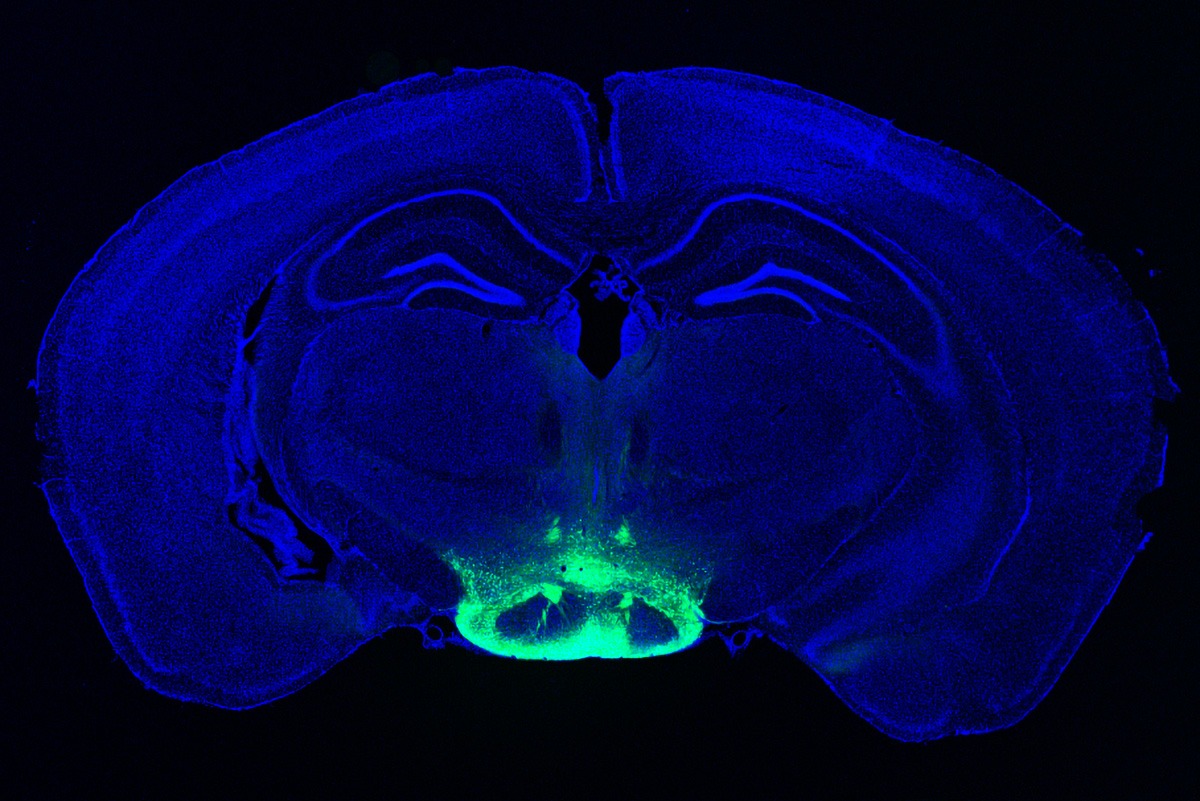
Neuronal hyperactivity and the gradual loss of neuron function are key features of Alzheimer’s disease. Now researchers led by Li-Huei Tsai, director of MIT’s Picower Institute for Learning and Memory, have identified the cells most susceptible to this damage, suggesting a good target for treatment. Even more exciting, Tsai and her colleagues have found a way to reverse neurodegeneration and other symptoms by interfering with an enzyme that is typically overactive in the brains of Alzheimer’s patients.
In one study , the researchers used single-cell RNA sequencing to distinguish two populations of neurons in the mammillary bodies, a pair of structures in the hypothalamus that play a role in memory and are affected early in the disease. Previous work by Tsai’s lab found that they had the highest density of amyloid beta plaques, abnormal clumps of protein that are thought to cause many Alzheimer’s symptoms.
The researchers found that neurons in the lateral mammillary body showed much more hyperactivity and degeneration than those in the larger medial mamillary body. They also found that this damage led to memory impairments in mice and that they could reverse those impairments with a drug used to treat epilepsy.
In the other study , the researchers treated mice with a peptide that blocks a hyperactive version of an enzyme called CDK5, which plays an important role in development of the central nervous system. They found dramatic reductions in neurodegeneration and DNA damage in the brain, and the mice got better at tasks such as learning to navigate a water maze.
CDK5 is activated by a smaller protein known as P35, allowing it to add a phosphate molecule to its targets. However, in Alzheimer’s and other neurodegenerative diseases, P35 breaks down into a smaller protein called P25, which allows CDK5 to phosphorylate other molecules—including the Tau protein, leading to the Tau tangles that are another characteristic of Alzheimer’s.
Pharmaceutical companies have tried to target P25 with small-molecule drugs, but these drugs also interfere with other essential enzymes. The MIT team instead used a peptide—a string of amino acids, in this case a sequence matching that of a CDK5 segment that is critical to binding P25.
In tests on neurons in a lab dish, the researchers found that treatment with the peptide moderately reduced CDK5 activity. But in a mouse model that has hyperactive CDK5, they saw myriad beneficial effects, including reductions in DNA damage, neural inflammation, and neuron loss.
The treatment also produced dramatic improvements in a different mouse model of Alzheimer’s, which has a mutant form of the Tau protein. Tsai hypothesizes that the peptide might confer resilience to cognitive impairment in the brains of people with Tau tangles.
“We found that the effect of this peptide is just remarkable,” she says. “We saw wonderful effects in terms of reducing neurodegeneration and neuroinflammatory responses, and even rescuing behavior deficits.”
The researchers hope the peptide could eventually be used as a treatment not only for Alzheimer’s but for frontotemporal dementia, HIV-induced dementia, diabetes-linked cognitive impairment, and other conditions.
Keep Reading
Most popular, how scientists traced a mysterious covid case back to six toilets.
When wastewater surveillance turns into a hunt for a single infected individual, the ethics get tricky.
- Cassandra Willyard archive page
It’s time to retire the term “user”
The proliferation of AI means we need a new word.
- Taylor Majewski archive page
The problem with plug-in hybrids? Their drivers.
Plug-in hybrids are often sold as a transition to EVs, but new data from Europe shows we’re still underestimating the emissions they produce.
- Casey Crownhart archive page
Sam Altman says helpful agents are poised to become AI’s killer function
Open AI’s CEO says we won’t need new hardware or lots more training data to get there.
- James O'Donnell archive page
Stay connected
Get the latest updates from mit technology review.
Discover special offers, top stories, upcoming events, and more.
Thank you for submitting your email!
It looks like something went wrong.
We’re having trouble saving your preferences. Try refreshing this page and updating them one more time. If you continue to get this message, reach out to us at [email protected] with a list of newsletters you’d like to receive.
Featured Topics
Featured series.
A series of random questions answered by Harvard experts.
Explore the Gazette
Read the latest.

How do you read organization’s silence over rise of Nazism?

Got milk? Does it give you problems?

Cancer risk, wine preference, and your genes
Start of new era for alzheimer’s treatment.
Alvin Powell
Harvard Staff Writer
Expert discusses recent lecanemab trial, why it appears to offer hope for those with deadly disease
Researchers say we appear to be at the start of a new era for Alzheimer’s treatment. Trial results published in January showed that for the first time a drug has been able to slow the cognitive decline characteristic of the disease. The drug, lecanemab, is a monoclonal antibody that works by binding to a key protein linked to the malady, called amyloid-beta, and removing it from the body. Experts say the results offer hope that the slow, inexorable loss of memory and eventual death brought by Alzheimer’s may one day be a thing of the past.
The Gazette spoke with Scott McGinnis , an assistant professor of neurology at Harvard Medical School and Alzheimer’s disease expert at Brigham and Women’s Hospital , about the results and a new clinical trial testing whether the same drug given even earlier can prevent its progression.
Scott McGinnis
GAZETTE: The results of the Clarity AD trial have some saying we’ve entered a new era in Alzheimer’s treatment. Do you agree?
McGINNIS: It’s appropriate to consider it a new era in Alzheimer’s treatment. Until we obtained the results of this study, trials suggested that the only mode of treatment was what we would call a “symptomatic therapeutic.” That might give a modest boost to cognitive performance — to memory and thinking and performance in usual daily activities. But a symptomatic drug does not act on the fundamental pathophysiology, the mechanisms, of the disease. The Clarity AD study was the first that unambiguously suggested a disease-modifying effect with clear clinical benefit. A couple of weeks ago, we also learned a study with a second drug, donanemab, yielded similar results.
GAZETTE: Hasn’t amyloid beta, which forms Alzheimer’s characteristic plaques in the brain and which was the target in this study, been a target in previous trials that have not been effective?
McGINNIS: That’s true. Amyloid beta removal has been the most widely studied mechanism in the field. Over the last 15 to 20 years, we’ve been trying to lower beta amyloid, and we’ve been uncertain about the benefits until this point. Unfavorable results in study after study contributed to a debate in the field about how important beta amyloid is in the disease process. To be fair, this debate is not completely settled, and the results of Clarity AD do not suggest that lecanemab is a cure for the disease. The results do, however, provide enough evidence to support the hypothesis that there is a disease-modifying effect via amyloid removal.
GAZETTE: Do we know how much of the decline in Alzheimer’s is due to beta amyloid?
McGINNIS: There are two proteins that define Alzheimer’s disease. The gold standard for diagnosing Alzheimer’s disease is identifying amyloid beta plaques and tau neurofibrillary tangles. We know that amyloid beta plaques form in the brain early, prior to accumulation of tau and prior to changes in memory and thinking. In fact, the levels and locations of tau accumulation correlate much better with symptoms than the levels and locations of amyloid. But amyloid might directly “fuel the fire” to accelerated changes in tau and other downstream mechanisms, a hypothesis supported by basic science research and the findings in Clarity AD that treatment with lecanemab lowered levels of not just amyloid beta but also levels of tau and neurodegeneration in the blood and cerebrospinal fluid.
GAZETTE: In the Clarity AD trial, what’s the magnitude of the effect they saw?
McGINNIS: The relevant standards in the trial — set by the FDA and others — were to see two clinical benefits for the drug to be considered effective. One was a benefit on tests of memory and thinking, a cognitive benefit. The other was a benefit in terms of the performance in usual daily activities, a functional benefit. Lecanemab met both of these standards by slowing the rate of decline by approximately 25 to 35 percent compared to placebo on measures of cognitive and functional decline over the 18-month studies.
“In a perfect world, we’d have treatments that completely stop decline and even restore function. We’re not there yet, but this represents an important step toward that goal.”
Steven M. Smith
GAZETTE: What are the key questions that remain?
McGINNIS: An important question relates to the stages at which the interventions were done. The study was done in subjects with mild cognitive impairment and mild Alzheimer dementia. People who have mild cognitive impairment have retained their independence in instrumental activities of daily living — for example, driving, taking medications, managing finances, errands, chores — but have cognitive and memory changes beyond what we would attribute to normal aging. When people transition to mild dementia, they’re a bit further along. The study was for people within that spectrum but there’s some reason to believe that intervening even earlier might be more effective, as is the case with many other medical conditions.
We’re doing a study here called the AHEAD study that is investigating the effects of lecanemab when administered earlier, in cognitively normal individuals who have elevated brain amyloid, to see whether we see a preventative benefit. The hope is that we would at least see a delay to onset of cognitive impairment and a favorable effect not only on amyloid biomarkers, but other biomarkers that might capture progression of the disease.
GAZETTE: Is anybody in that study treatment yet or are you still enrolling?
McGINNIS: There’s a rolling enrollment, so there are people who are in the double-blind phase of treatment, receiving either the drug or the placebo. But the enrollment target hasn’t been reached yet so we’re still accepting new participants.
GAZETTE: Is it likely that we may see drug cocktails that go after tau and amyloid? Is that a future approach?
More like this
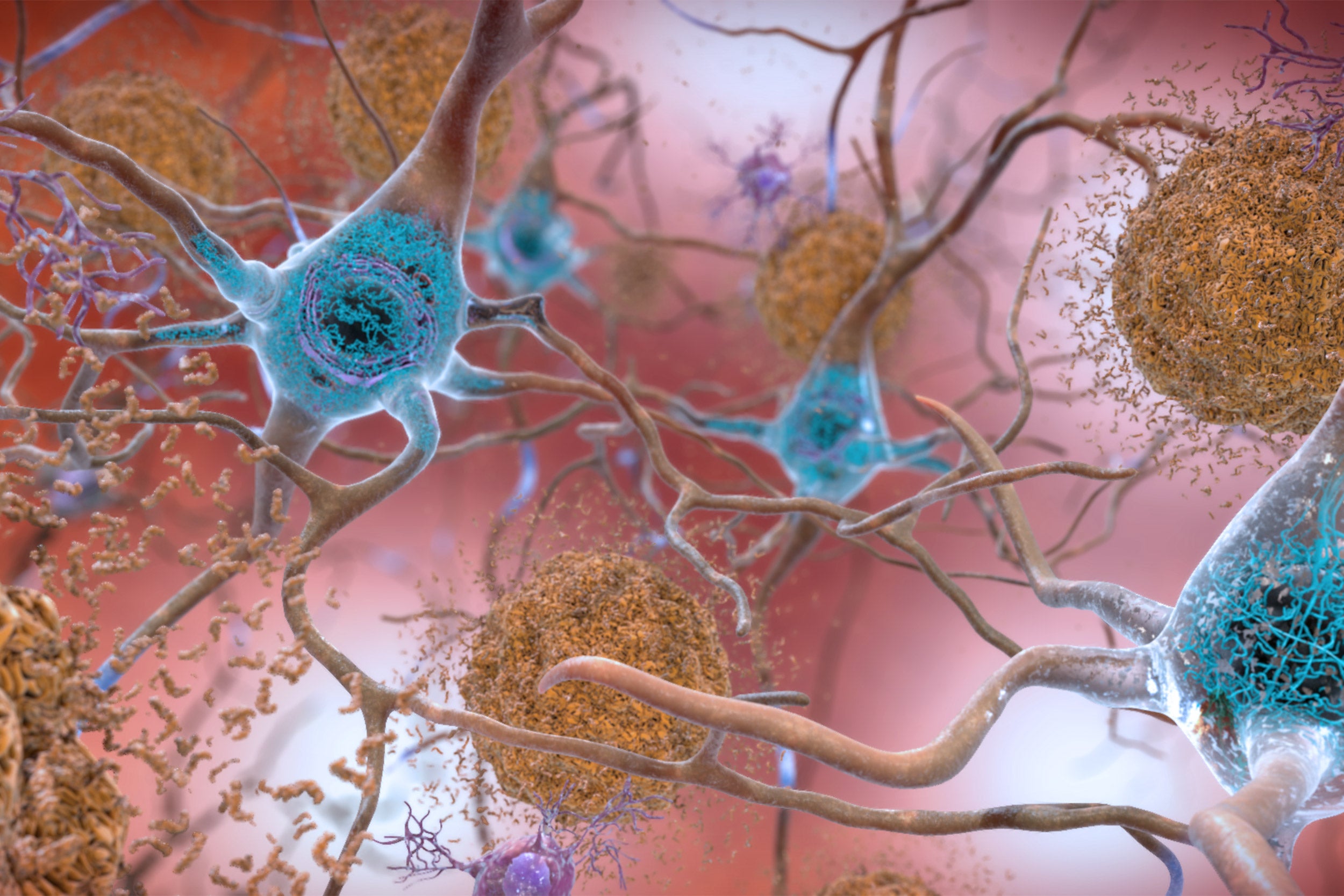
Newly identified genetic variant protects against Alzheimer’s
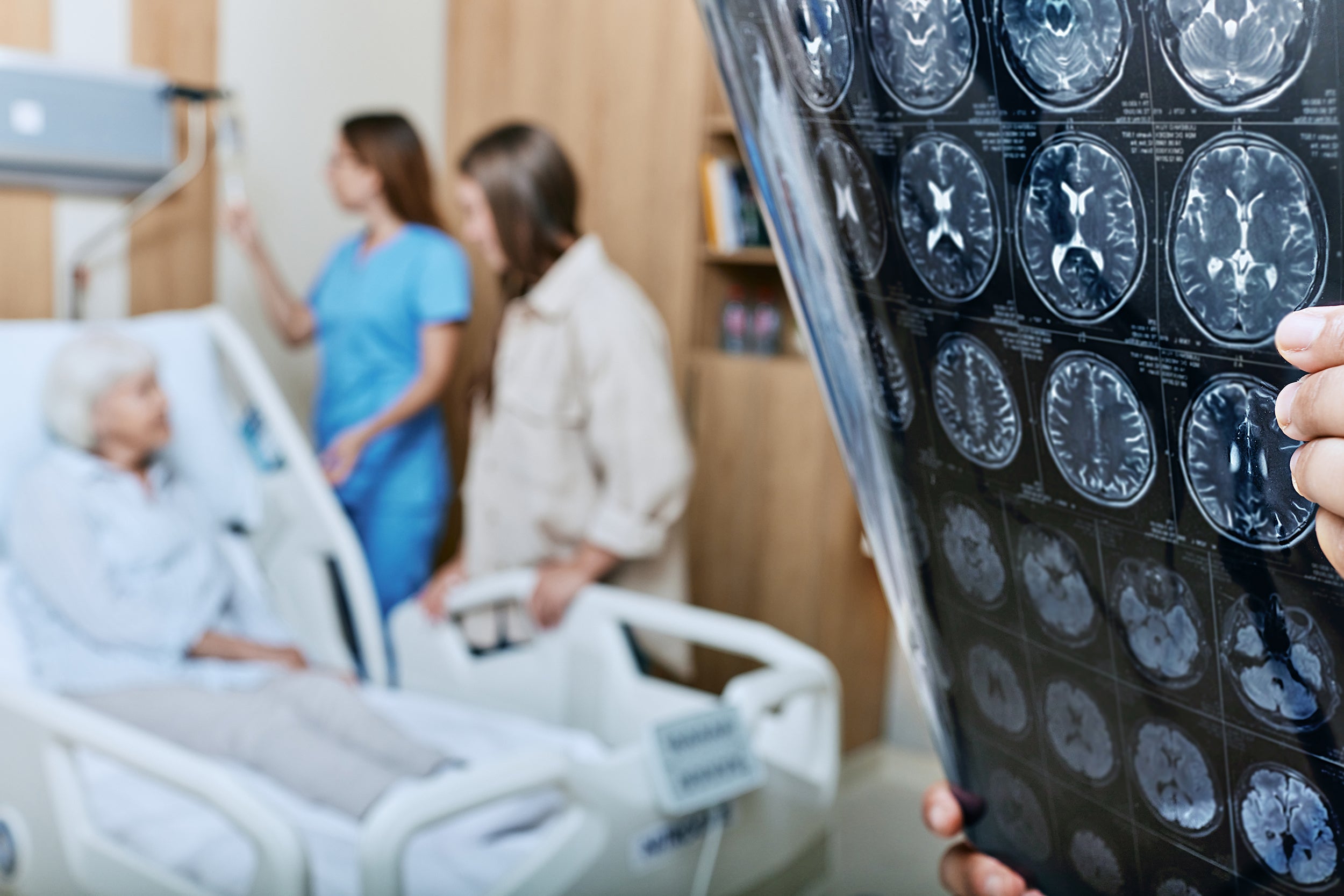
Using AI to target Alzheimer’s

Excessive napping and Alzheimer’s linked in study
McGINNIS: It has not yet been tried, but those of us in the field are very excited at the prospect of these studies. There’s been a lot of work in recent years on developing therapeutics that target tau, and I think we’re on the cusp of some important breakthroughs. This is key, considering evidence that spreading of tau from cell to cell might contribute to progression of the disease. Additionally, for some time, we’ve had a suspicion that we will likely have to target multiple different aspects of the disease process, as is the case with most types of cancer treatment. Many in our field believe that we will obtain the most success when we identify the most pertinent mechanisms for subgroups of people with Alzheimer’s disease and then specifically target those mechanisms. Examples might include metabolic dysfunction, inflammation, and problems with elements of cellular processing, including mitochondrial functioning and processing old or damaged proteins. Multi-drug trials represent a natural next step.
GAZETTE: What about side effects from this drug?
McGINNIS: We’ve known for a long time that drugs in this class, antibodies that harness the power of the immune system to remove amyloid, carry a risk of causing swelling in the brain. In most cases, it’s asymptomatic and just detected by MRI scan. In Clarity AD, while 12 to 13 percent of participants receiving lecanemab had some level of swelling detected by MRI, it was symptomatic in only about 3 percent of participants and mild in most of those cases.
Another potential side effect is bleeding in the brain or on the surface of the brain. When we see bleeding, it’s usually very small, pinpoint areas of bleeding in the brain that are also asymptomatic. A subset of people with Alzheimer’s disease who don’t receive any treatment are going to have these because they have amyloid in their blood vessels, and it’s important that we screen for this with an MRI scan before a person receives treatment. In Clarity AD, we saw a rate of 9 percent in the placebo group and about 17 percent in the treatment group, many of those cases in conjunction with swelling and mostly asymptomatic.
The scenario that everybody worries about is a hemorrhagic stroke, a larger area of bleeding. That was much less common in this study, less than 1 percent of people. Unlike similar studies, this study allowed subjects to be on anticoagulation medications, which thin the blood to prevent or treat clots. The rate of macro hemorrhage — larger bleeds — was between 2 and 3 percent in the anticoagulated participants. There were some highly publicized cases including a patient who had a stroke, presented for treatment, received a medication to dissolve clots, then had a pretty bad hemorrhage. If the drug gets full FDA approval, is covered by insurance, and becomes clinically available, most physicians are probably not going to give it to people who are on anticoagulation. These are questions that we’ll have to work out as we learn more about the drug from ongoing research.
GAZETTE: Has this study, and these recent developments in the field, had an effect on patients?
McGINNIS: It has had a considerable impact. There’s a lot of interest in the possibility of receiving this drug or a similar drug, but our patients and their family members understand that this is not a cure. They understand that we’re talking about slowing down a rate of decline. In a perfect world, we’d have treatments that completely stop decline and even restore function. We’re not there yet, but this represents an important step toward that goal. So there’s hope. There’s optimism. Our patients, particularly patients who are at earlier stages of the disease, have their lives to live and are really interested in living life fully. Anything that can help them do that for a longer period of time is welcome.
Share this article
You might like.
Medical historians look to cultural context, work of peer publications in wrestling with case of New England Journal of Medicine

Biomolecular archaeologist looks at why most of world’s population has trouble digesting beverage that helped shape civilization

Biologist separates reality of science from the claims of profiling firms
Epic science inside a cubic millimeter of brain
Researchers publish largest-ever dataset of neural connections
How far has COVID set back students?
An economist, a policy expert, and a teacher explain why learning losses are worse than many parents realize
Pop star on one continent, college student on another
Model and musician Kazuma Mitchell managed to (mostly) avoid the spotlight while at Harvard
Thank you for visiting nature.com. You are using a browser version with limited support for CSS. To obtain the best experience, we recommend you use a more up to date browser (or turn off compatibility mode in Internet Explorer). In the meantime, to ensure continued support, we are displaying the site without styles and JavaScript.
- View all journals
Alzheimer's disease articles from across Nature Portfolio
Alzheimer's disease is a progressive neurodegenerative disease that impairs memory and cognitive judgment and is often accompanied by mood swings, disorientation and eventually delirium. It is the most common cause of dementia.

APOE4 homozygosity is a new genetic form of Alzheimer’s disease
New data confirm that APOE4 homozygosity is a major genetic cause of Alzheimer’s disease, warranting the development of specialized research strategies, treatment approaches and clinical trials.
- Zherui Liang
- Yadong Huang
Latest Research and Reviews

p75 neurotrophin receptor modulation in mild to moderate Alzheimer disease: a randomized, placebo-controlled phase 2a trial
A phase 2a trial of LM11A-31 in mild to moderate Alzheimer disease suggests that p75 NTR modulation is safe and attenuates measures of degeneration.
- Hayley R. C. Shanks
- Taylor W. Schmitz
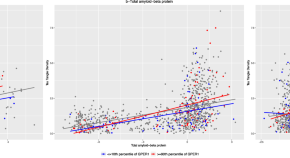
G-protein coupled estrogen receptor 1, amyloid-β, and tau tangles in older adults
GPER1 RNA expression is linked to tau tangles and modifies the relation of amyloidβ with tau tangles.
- Shahram Oveisgharan
- David A. Bennett
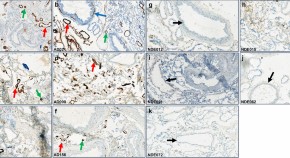
Amyloid-beta antibody binding to cerebral amyloid angiopathy fibrils and risk for amyloid-related imaging abnormalities
- Linda Söderberg
- Malin Johannesson
- Christer Möller
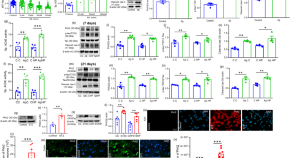
Pirh2 modulates the mitochondrial function and cytochrome c-mediated neuronal death during Alzheimer’s disease
- Abhishek Singh
- Shubhangini Tiwari
- Sarika Singh
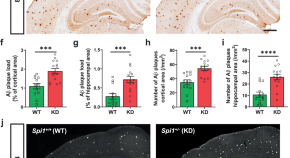
Effects of SPI1 -mediated transcriptome remodeling on Alzheimer’s disease-related phenotypes in mouse models of Aβ amyloidosis
Although SPI1 gene was identified as a risk factor for Alzheimer’s disease, its role in the disease remains unclear. Here, the authors show that decreasing SPI1 level exacerbates disease symptoms, whereas increasing its level ameliorates phenotypes.
- Byungwook Kim
- Luke Child Dabin
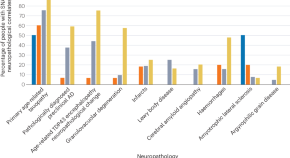
The clinical importance of suspected non-Alzheimer disease pathophysiology
Suspected non-AD pathophysiology (SNAP) is a biomarker-based concept that describes individuals with normal amyloid and abnormal tau and/or neurodegeneration biomarker status. This Review discusses the origins of the SNAP construct, along with its prevalence, diagnostic and prognostic implications, and underlying neuropathology.
- Stephanie J. B. Vos
- Aurore Delvenne
- Pieter Jelle Visser
News and Comment
Genetic protection against alzheimer disease, including tau inclusions.
- Rebecca Wright
Neuronal activity drives glymphatic waste clearance
Two new studies show that clearance of waste, including pathogenic amyloid, through the glymphatic system is driven by synchronized neuronal activity.
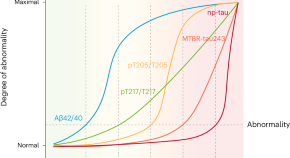
Five biomarkers from one cerebrospinal fluid sample to stage Alzheimer’s disease
Staging Alzheimer’s disease on the basis of the disease’s biological underpinnings might help with stratification and prognostication, both in the clinical setting and in clinical trials. We propose a staging model based on only five biomarkers, which are related to amyloid-β and tau pathologies in different ways and can be measured with a single sample of cerebrospinal fluid.
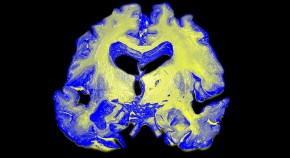
A test for Alzheimer’s-disease stage predicts dementia risk
Levels of a host of molecules in the cerebrospinal fluid reliably assess development of the disease.
Quick links
- Explore articles by subject
- Guide to authors
- Editorial policies
- International edition
- Australia edition
- Europe edition

New Alzheimer’s drug slows cognitive decline by 35%, trial results show
Donanemab is second drug in a year to succeed in trials in what could be ‘beginning of the end’ of disease
A new Alzheimer’s drug slowed cognitive decline by 35%, according to late-stage trial results, raising the prospect of a second effective treatment for the disease.
Donanemab met all goals of the trial and slowed progression of the condition by 35% to 36% compared with a placebo in 1,182 people with early-stage Alzheimer’s, the drugmaker Lilly said.
It comes after trial results published last year showed that lecanemab , made by Eisai and Biogen, reduced the rate of cognitive decline by 27% in patients with early Alzheimer’s.
“This could be the beginning of the end of Alzheimer’s disease,” said Dr Richard Oakley, the associate director of research at the Alzheimer’s Society in the UK. “After 20 years with no new Alzheimer’s drugs, we now have two potential new drugs in just 12 months – and for the first time, drugs that seem to slow the progression of disease.”
Maria Carrillo, the chief science officer of the Alzheimer’s Association in the US, also hailed donanemab’s trial results. “These are the strongest phase 3 data for an Alzheimer’s treatment to date,” she said.
Alzheimer’s is the most common cause of dementia, one of the world’s biggest health threats. The number of people living with dementia globally is forecast to nearly triple to 153 million by 2050, and experts have said it presents a rapidly growing threat to future health and social care systems in every community, country and continent.
In patients on donanemab, 47% showed no signs of the disease progressing after a year, according to a statement issued by Lilly . That compared to 29% on a placebo.
The drug resulted in 40% less decline in the ability to perform activities of daily living, the company said. Patients on donanemab also experienced a 39% lower risk of progressing to the next stage of disease compared to those on a placebo.
However, the company also reported side-effects.
Brain swelling occurred in 24% of those on donanemab, with 6.1% experiencing symptoms, Lilly said. Brain bleeding occurred in 31.4% of the donanemab group and 13.6% of the placebo group.
Lilly also said the incidence of serious brain swelling in the donanemab study was 1.6%, including two deaths attributed to the condition and a third death after an incident of serious brain swelling.
“The treatment effect is modest, as is the case for many first-generation drugs, and there are risks of serious side-effects that need to be fully scrutinised before donenemab can be marketed and used,” said Dr Susan Kohlhaas, the executive director of research and partnerships at Alzheimer’s Research UK.
But she said the results were still “incredibly encouraging” and represented “another hugely significant moment for dementia research”.
“We’re now on the cusp of a first generation of treatments for Alzheimer’s disease, something that many thought impossible only a decade ago,” she added. “People should be really encouraged by this news, which is yet more proof that research can take us ever closer towards a cure.”
Lilly said it planned to apply for approval from the US Food and Drug Administration next month, and with regulators in other countries shortly thereafter.
“At face value, these data look positive, but we need to see the full dataset,” said Dr Liz Coulthard, an associate professor in dementia neurology at the University of Bristol.
“Donanemab seems to help people with early Alzheimer’s retain cognitive function for longer – and this effect looks to be clinically meaningful. Donanemab might help people live well with Alzheimer’s for longer. If approved alongside lecanemab, this potentially brings a choice of treatments for patients.”
- Alzheimer's
- Pharmaceuticals industry
Most viewed
Suggestions or feedback?
MIT News | Massachusetts Institute of Technology
- Machine learning
- Social justice
- Black holes
- Classes and programs
Departments
- Aeronautics and Astronautics
- Brain and Cognitive Sciences
- Architecture
- Political Science
- Mechanical Engineering
Centers, Labs, & Programs
- Abdul Latif Jameel Poverty Action Lab (J-PAL)
- Picower Institute for Learning and Memory
- Lincoln Laboratory
- School of Architecture + Planning
- School of Engineering
- School of Humanities, Arts, and Social Sciences
- Sloan School of Management
- School of Science
- MIT Schwarzman College of Computing
Alzheimer's
Download RSS feed: News Articles / In the Media / Audio

Navigating longevity with industry leaders at MIT AgeLab PLAN Forum
A symposium for financial professionals imagines a new industry around longevity planning.
May 16, 2024
Read full story →
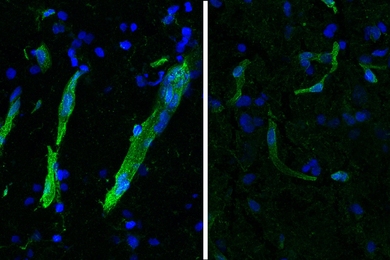
Study: Movement disorder ALS and cognitive disorder FTLD show strong molecular overlaps
Single-cell gene expression patterns in the brain, and evidence from follow-up experiments, reveal many shared cellular and molecular similarities that could be targeted for potential treatment.
March 22, 2024

Envisioning a time when people age without fear of dementia
Moved by the human devastation and scientific conundrum of Alzheimer’s, William Li seeks to work on therapies for the disease.
March 15, 2024
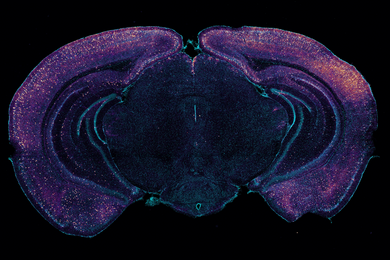
How sensory gamma rhythm stimulation clears amyloid in Alzheimer’s mice
Study finds stimulating a key brain rhythm with light and sound increases peptide release from interneurons, driving clearance of an Alzheimer’s protein.
March 7, 2024
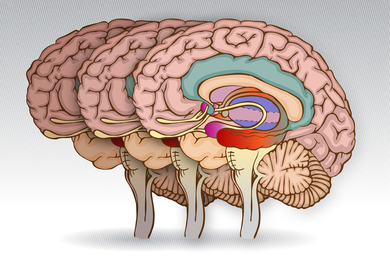
How cognition changes before dementia hits
Study finds language-processing difficulties are an indicator — in addition to memory loss — of amnestic mild cognitive impairment.
February 29, 2024
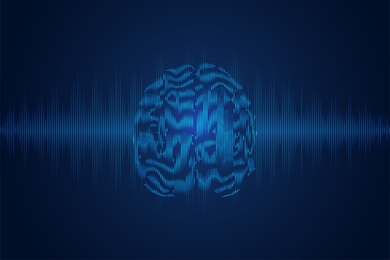
Evidence that gamma rhythm stimulation can treat neurological disorders is emerging
Researchers survey a broadening landscape of studies showing what’s known, and what remains to be found, about the therapeutic potential of noninvasive sensory, electrical, or magnetic stimulation of gamma brain rhythms.
January 18, 2024
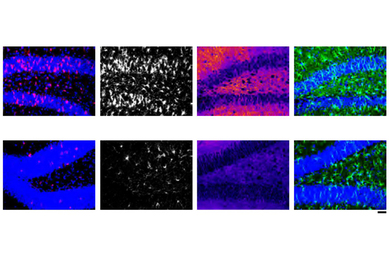
Nanoparticle-delivered RNA reduces neuroinflammation in lab tests
MIT researchers find that in mice and human cell cultures, lipid nanoparticles can deliver a potential therapy for inflammation in the brain, a prominent symptom in Alzheimer’s.
December 15, 2023
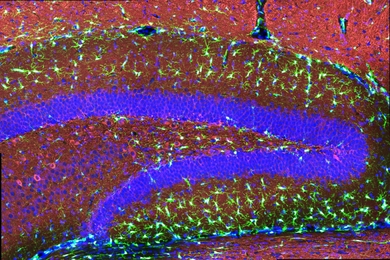
How a mutation in microglia elevates Alzheimer’s risk
A new study finds that microglia with mutant TREM2 protein reduce brain circuit connections, promote inflammation, and contribute to Alzheimer’s pathology in other ways.
December 4, 2023
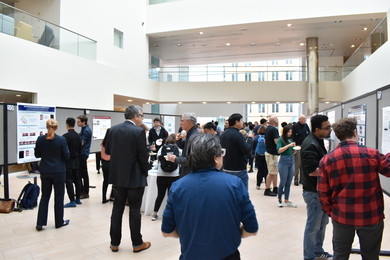
Aging Brain Initiative symposium showcases “cutting-edge” research across MIT
Seed projects, posters represent a wide range of labs working on technologies, therapeutic strategies, and fundamental research to advance understanding of age-related neurodegenerative disease.
November 16, 2023

A new wave of treatment for Alzheimer’s disease
Professor Li-Huei Tsai studies how brain waves can be used to treat neurodegenerative diseases such as Alzheimer’s.
November 15, 2023

2023-24 Takeda Fellows: Advancing research at the intersection of AI and health
Thirteen new graduate student fellows will pursue exciting new paths of knowledge and discovery.
November 2, 2023
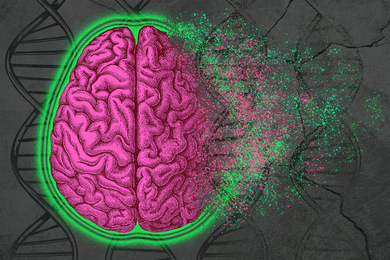
Decoding the complexity of Alzheimer’s disease
By analyzing epigenomic and gene expression changes that occur in Alzheimer’s disease, researchers identify cellular pathways that could become new drug targets.
September 28, 2023
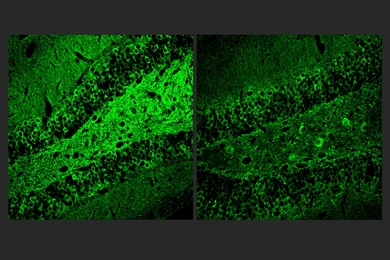
Molecule reduces inflammation in Alzheimer’s models
A potential new Alzheimer’s drug represses the harmful inflammatory response of the brain’s immune cells, reducing disease pathology, preserving neurons, and improving cognition in preclinical tests.
September 5, 2023
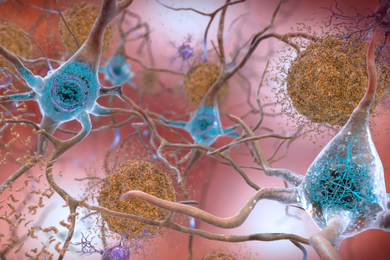
How Tau tangles form in the brain
A new study shows that truncated versions of the Tau protein are more likely to form the sticky filaments seen in the brains of people with Alzheimer’s disease.
July 14, 2023
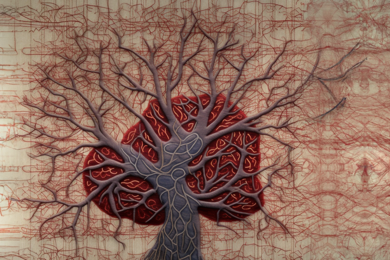
Atlas of human brain blood vessels highlights changes in Alzheimer’s disease
MIT researchers characterize gene expression patterns for 22,500 brain vascular cells across 428 donors, revealing insights for Alzheimer’s onset and potential treatments.
June 21, 2023
Massachusetts Institute of Technology 77 Massachusetts Avenue, Cambridge, MA, USA
- Map (opens in new window)
- Events (opens in new window)
- People (opens in new window)
- Careers (opens in new window)
- Accessibility
- Social Media Hub
- MIT on Facebook
- MIT on YouTube
- MIT on Instagram
New class of Alzheimer's drugs showing promise in patients in early stage of disease
For decades scientists and families have been frustrated by the intractable nature of Alzheimer's disease.
Key points:
- A study showed donanemab could slow Alzheimer's disease progression by 35pc in patients in the earliest stages of the disease
- Geriatrician Michael Woodward says the medical community is excited by the results
- The donanemab study findings were similar to those of its predecessor lecanemab
As the population ages and more people develop the devastating condition, there have been no new treatments coming onto the market and for many, no hope in sight.
That was until two years ago.
In a short time, decades of research has started to come to fruition, with at least three new drugs demonstrating the first glimmers of promise.
The latest is called donanemab, with the findings of a global trial involving 1,700 patients presented at a major Alzheimer's conference in The Netherlands.
Sixteen Australians took part in the trial at eight sites in Victoria and New South Wales.
The drug, from pharmaceutical giant Eli Lilly, was able to slow Alzheimer's disease progression by 35 per cent in patients in the earliest stages of the disease.
Across the whole study, there was a 22 per cent slowdown in the disease's progress at the 18-month mark.
Michael Woodward, a geriatrician who has been involved in Alzheimer's research for decades, was at the Alzheimer's conference and said the medical community was excited by the results.
"I would regard this as the end of the beginning in Alzheimer's therapies," he said.
"The word breakthrough is used perhaps a little too often, but this is a major breakthrough.
"We now have three drugs that have been shown that can critically slow down the decline."
How does the new drug work?
Donanemab is a monoclonal antibody designed to clear the brain of amyloid plaque, which experts believe plays a role in Alzheimer's disease.
Researchers have long been trying to work out whether a protein called beta-amyloid plaque (BAP) or another protein called tau is responsible for Alzheimer's, or a combination of the two.
Those in the study were all in the early stages of Alzheimer's and aged between 60 and 85.
At the 12-month mark, the researchers said 47 per cent had no evidence of amyloid plaques, compared with 29 per cent in the placebo group.
Patients also did not need indefinite treatment, with injections being able to reduce amyloid to non-existent levels where they would not re-accumulate for many years.
Stephen Macfarlane had three patients in the study through his work with The Dementia Centre at HammondCare in Victoria.
He said the medication was the equivalent of slowing the rate of the disease by seven and a half months compared to someone who was not taking it.
"These drugs slow the progression of the disease, they don't cause people to improve," Dr Macfarlane said.
He said it was the most promising drug in two decades for Alzheimer's research.
"It's the most effective, and the safety data seems to be on a par with similar drugs," he said.
The findings show there was a risk of brain bleeding and swelling in a subset of patients, including 1.6 per cent of participants who experienced serious forms, and three who died.
"Bearing in mind that Alzheimer's disease is a fatal and otherwise untreatable illness, some degree of risk is inherent in the process," Dr Macfarlane said.
Drug follows on heels of another, lecanemab
The donanemab study findings were similar to those of its predecessor lecanemab, sold under the brand name Leqembi.
It reduced cognitive decline by 27 per cent in patients with early Alzheimer's in a study published last year.
Lou Coenen is among the Australian patients in a lecanemab trial.
This drug from Japanese drug maker Eisa is being tested in four trials that include Australian sites across 18 locations.
The 72-year-old was diagnosed with Alzheimer's about five years ago and had a family history of the disease.
"You just start feeling your thinking doesn't work quite as fast," Mr Coenen said.
"You start to wonder why."
He decided to take part in a clinical trial of lecanemab through the KaRa Institute of Neurological Diseases to help give back to the health community.
He says he does notice a difference on the medication.
It is allowing him to spend more time with his wife and family and still participate in community activities such as The Men's Shed.
"I know compared to other people this is working," he said. "But I don't have a comparative of another me that says otherwise."
On June 30 Australia's Therapeutic Goods Administration (TGA) started work to consider approving lecanemab in Australia.
This drug has shown similar results to donanemab in patients with early Alzheimer's but also comes with risks of brain swelling and bleeding in a small subset of patients.
How much will it cost?
New Alzheimer's drugs to the market are predicted to be hugely expensive for governments because of the significant time and cost they took to develop.
Leqembi is priced at about $US26,500 ($39,974) for a year's supply of infusions every two weeks but there is no potential price for donanemab yet, which will involve monthly injections.
"That's going to be a big challenge," Dr Woodward said.
"But we've got to look also at the savings. The total cost of care for Alzheimer's disease is probably closer to about $6-7 billion per year in Australia."
Dr Macfarlane said the drug would also mean Australia would need to revamp its Alzheimer's infrastructure so PET scans were more available for early diagnoses, regular hospital infusions were easier to access, and patients were diagnosed much sooner.
"We know in Australia that on average there's about a three-year delay between people first experiencing symptoms of memory loss and actually receiving a diagnosis," he said.
Biogen drug caused controversy
The drugs follow the groundbreaking but controversial release of Biogen's Aducanumab in 2021.
It is another monoclonal antibody that also works by removing the build-up of amyloid plaque proteins.
It was controversial because of the way the research was structured and the pharmaceutical company's relationship with US regulators.
In June this year the Therapeutic Goods Administration found the drug did not meet its safety and efficacy requirements for approval in Australia and Biogen withdrew its application.
Latest findings bring hope for patients
For Melbourne grandmother Jan Cody, the first sign she knew her memory was failing was when her three children met to discuss her declining mental state.
The 75-year-old had to give up her work as a psychologist, as well as cooking and driving.
"My world just shrank. There's really no medication to take," she said.
She has been involved in some Alzheimer's trials but was not eligible for donanemab.
"The slowing it down takes a long time," she said. "So one really doesn't know whether you're going to last."
"But now I do have a glimmer of hope."
- X (formerly Twitter)
Related Stories
Promising alzheimer's drug gets green light in us as australia evaluates application.

US regulators have approved the first Alzheimer's drug in two decades. And it's creating controversy
- Alzheimer's and Dementia
- Brain and Nervous System
- Diseases and Disorders
- Health Policy
- Medical Research
- Netherlands
- Pharmaceuticals
- United States
- Skip to main content
- Keyboard shortcuts for audio player
- Your Health
- Treatments & Tests
- Health Inc.
- Public Health
Shots - Health News
Alzheimer's researchers are looking beyond plaques and tangles for new treatments.

Jon Hamilton

Scientists say research into Alzheimer's needs to take a broader view of how the disease affects the brain — whether that's changes in the cortex or the role of inflammation. Matt York/AP hide caption
Scientists say research into Alzheimer's needs to take a broader view of how the disease affects the brain — whether that's changes in the cortex or the role of inflammation.
The field of Alzheimer's research is branching out.
After decades of focusing on the sticky amyloid plaques and tangled tau fibers associated with the disease, brain researchers are searching for other potential causes of impaired memory and thinking.
That search is on full display this week at the Alzheimer's Association International Conference in San Diego, where sessions are exploring factors including genes, brain injury, clogged arteries and inflammation.
A group of researchers from Seattle even unveiled a highly detailed atlas showing how different types of brain cells change in Alzheimer's. The goal is to help scientists identify new approaches to treatment.
"Certainly, plaques and tangles are a hallmark," says Maria Carrillo , chief science officer of the Alzheimer's Association. "It doesn't mean plaques are the cause of cell death."
Plaques are clumps of a protein called beta-amyloid that appear in the spaces between neurons. Tangles are made up of a protein called tau that appears inside a neuron.
Both proteins tend to accumulate in the brains of people with Alzheimer's. But their role in killing brain cells is still unclear.
Carrillo says the Alzheimer's field needs to look to cancer research where a deeper understanding of the disease has led to better treatments.
The shift comes after a series of experimental drugs have succeeded in removing amyloid plaques and tau tangles from the brain, but failed to halt the disease.
The Food and Drug Administration has approved one amyloid drug, Aduhelm, but is still evaluating whether it actually helps patients.
An Alzheimer's Atlas
The study that produced the atlas is emblematic of how researchers are recalibrating.
"What we're trying to do with this study is to look at cell vulnerability early on in disease, before [people] have plaques and tangles, before they have cognitive impairment," says Dr. C. Dirk Keene , a neuropathologist at the University of Washington.
To create the atlas, Keene and a team of researches analyzed more than a million cells from 84 brains donated by people who'd signed up for Alzheimer's research projects run by the University of Washington and Kaiser Permanente Washington Research Institute.
The brains came from donors "at all different stages of disease" Keene says, "so we can pinpoint what's happening from the earliest levels all the way through to people with advanced disease."
The effort is funded by the National Institute on Aging and grew out of the federal BRAIN initiative launched by President Obama in 2013.
The atlas came from the realization that "If we want to treat diseases of an extremely complex cellular organ, you need to understand that organ much better than we do," says Ed Lein , a senior investigator at the Allen Institute for Brain Science, which played a key role in analyzing the brain tissue.
So the team spent years studying cells in healthy brains before looking at brains affected by Alzheimer's.
"We've defined what a normal adult brain looks like," Lein says, "and now we can use that knowledge and look for changes that are happening in specific kinds of cells."

Future Alzheimer's Treatments Aim To Do More Than Clear Plaques From The Brain
Finding vulnerable brain cells.
At the Alzheimer's meeting, the team described changes they saw in more than 100 types of cells taken from the cortex — an area of the brain which is important to memory and thinking.
One finding was that neurons that make connections within the cortex itself were much more likely to die than those that connect to distant areas of the brain.
"What we're seeing is a profound effect on cortical circuitry that very plausibly is the reason we have cognitive decline," Lein says.
If so, a treatment designed to protect those vulnerable neurons might prevent declines in memory and thinking linked to Alzheimer's.
The team also found a proliferation of brain cells that contribute to inflammation. These included certain immune cells and a type of cell that responds to injury.
"So while the neurons are lost, the non-neuronal cells are actually increasing and changing" Lein says.
The finding supports the idea that inflammation plays an important role in Alzheimer's, and that anti-inflammatory drugs might help protect the brain.
The Seattle team hopes other scientists will use the brain cell atlas to come up with new treatments for Alzheimer's.
"We've created an open-access resource where the whole community can come and look at this data," Lein says. "They can mine it to speed up progress in the field as a whole."
Speeding up progress is one reason Kyle Travaglini , a researcher at the Allen Institute, jumped at the chance to work on the Alzheimer's project.
"My grandmother started developing Alzheimer's disease when I was just going off to college," says Travaglini, who received his PhD in 2021.
Travaglini says the atlas project is appealing because it isn't based on a preconceived idea about what causes Alzheimer's.
"It's like looking at the same disease that everyone has been looking at but in an entirely different way," he says.

A substance found in young spinal fluid helps old mice remember

Scientists look to people with Down syndrome to test Alzheimer's drugs
Alzheimer's Research News
Top headlines, latest headlines.
- Alzheimer's Disease and Neuronal Growth
- Prevention of Dementia
- Alzheimer's Disease Without Symptoms
- Robots' Sense of Touch as Fast as Humans?
- Sleep Apnea Severity and Verbal Memory
- Alzheimer's: Epigenetics and Environment
- Some Brain Cells Age Faster in Alzheimer's
- Tiny Brains in a Petri Dish
- New Type of Memory State
- Companies May Buy Consumer Genetic Info
Earlier Headlines
Wednesday, may 1, 2024.
- Nutrient Research Reveals Pathway for Treating Brain Disorders
- A Blood Test for Stroke Risk? Biomarker for Risk of Future Cerebrovascular Disease
Tuesday, April 30, 2024
- Student Links Worm Behavior to Brain Disease
- Researchers Target Neurogenesis in New Approach to Treat Parkinson's Disease
Friday, April 26, 2024
- Imaging Technique Shows New Details of Peptide Structures
Thursday, April 25, 2024
- RNA Modification Is Responsible for the Disruption of Mitochondrial Protein Synthesis in Alzheimer's Disease
- Nanomaterial That Mimics Proteins Could Be Basis for New Neurodegenerative Disease Treatments
- National Trial Safely Scaled Back Prescribing of a Powerful Antipsychotic for the Elderly
Wednesday, April 24, 2024
- Good Heart Health in Middle Age May Preserve Brain Function Among Black Women as They Age
Tuesday, April 23, 2024
- Wake Up and Die: Human Brain Neurons Re-Entering the Cell Cycle Age Quickly Shift to Senescence
- Innovative Microscopy Demystifies Metabolism of Alzheimer's
Monday, April 22, 2024
- AI Can Improve Alzheimer's Treatment Through the 'gut-Brain Axis'
- Study Explores Possible Future for Early Alzheimer's Diagnostics
Wednesday, April 17, 2024
- Protecting Brain Cells With Cannabinol
- Workings of Working Memory Detailed
Tuesday, April 16, 2024
- Common HIV Treatments May Aid Alzheimer's Disease Patients
Monday, April 15, 2024
- Take It from the Rats: A Junk Food Diet Can Cause Long-Term Damage to Adolescent Brains
Thursday, April 11, 2024
- Parkinson's Disease: New Theory on the Disease's Origins and Spread
Monday, April 8, 2024
- Tiny Brain Bubbles Carry Complete Codes
Thursday, April 4, 2024
- Organoids Reveal How to Protect the Brain Against Dementia and ALS Following Traumatic Injury, According to Study
Wednesday, April 3, 2024
- Immunotherapy for Alzheimer's Disease Shows Promise in Mouse Study
Tuesday, April 2, 2024
- Blended Antioxidant Supplement Improves Cognition and Memory in Aged Mice
- Simulations Reveal Mechanism Behind Protein Build-Up in Parkinson's Disease
Monday, April 1, 2024
- App May Pave Way to Treatments for No. 1 Dementia in Under-60s
Thursday, March 28, 2024
- New Imaging Method Illuminates Oxygen's Journey in the Brain
- Familial Alzheimer's Disease Transferred Via Bone Marrow Transplant in Mice
Wednesday, March 27, 2024
- Making Long-Term Memories Requires Nerve-Cell Damage
- Risk Factors for Faster Aging in the Brain Revealed in New Study
- Memory Self-Test Via Smartphone Can Identify Early Signs of Alzheimer's Disease
Tuesday, March 26, 2024
- New Treatment Target Identified for Alzheimer's Disease
- Common Degenerative Brain Disease May Begin to Develop in Middle Age
- Large-Scale Animal Study Links Brain pH Changes to Wide-Ranging Cognitive Issues
Monday, March 25, 2024
- Human Brains Are Getting Larger: That May Be Good News for Dementia Risk
Friday, March 22, 2024
- Physicists Develop Modeling Software to Diagnose Serious Diseases
- Movement Disorder ALS and Cognitive Disorder FTLD Show Strong Molecular Overlaps, New Study Shows
Thursday, March 21, 2024
- Novel Genetic Variants Associated With Alzheimer's Disease
- Immune Cells Identified as Key Players in Brain Health
Wednesday, March 20, 2024
- Rural and Minority Dementia Patients Face Disparities in Access to Neurologists
- Keto Diet Prevents Early Memory Decline in Mice
Tuesday, March 19, 2024
- Biomarkers of the Middle-Aged Brain Predict Cognitive Health in Old Age
Thursday, March 14, 2024
- A Healthier Diet Is Linked With a Slower Pace of Aging, Reduced Dementia Risk, Study Shows
- Alzheimer's Drug Fermented With Help from AI and Bacteria Moves Closer to Reality
Wednesday, March 13, 2024
- Blast-Related Concussions Linked to Higher Alzheimer's Risk
- Genetic Condition Haemochromatosis Linked to Higher Levels of Disease in Older People
- Integrity of Blood-Brain Barrier Depends on Protein That Is Altered in Some Neurodegenerative Diseases
- Recreational Activities Such as Golfing, Gardening May Be Associated With Increased ALS Risk Among Men
Tuesday, March 12, 2024
- 'Curved' Walking and a Depth Camera: New Tool Detects Early Cognitive Decline
Monday, March 11, 2024
- Researchers Identify Gene Involved in Neuronal Vulnerability in Alzheimer's Disease
- Wrist Device That Monitors Activity Could Help Provide Early Warning of Alzheimer's
Wednesday, March 6, 2024
- Earliest-Yet Alzheimer's Biomarker Found in Mouse Model Could Point to New Targets
- A Noninvasive Treatment for 'chemo Brain'
- Amyloid Blood Levels Associated With Brain Changes in Alzheimer's Study
Thursday, February 29, 2024
- Tiny Magnetic Particles in Air Pollution Linked to Development of Alzheimer's
- How Cognition Changes Before Dementia Hits
- Mutations in Hereditary Alzheimer's Disease Damage Neurons Without 'usual Suspect' Amyloid Plaques
- Poor Spatial Navigation Could Predict Alzheimer's Disease Years Before the Onset of Symptoms
Wednesday, February 28, 2024
- More Than Just Neurons: A New Model for Studying Human Brain Inflammation
- How 40Hz Sensory Gamma Rhythm Stimulation Clears Amyloid in Alzheimer's Mice
Monday, February 26, 2024
- Yoga Provides Unique Cognitive Benefits to Older Women at Risk of Alzheimer's Disease
Wednesday, February 21, 2024
- Air Pollution Linked to More Signs of Alzheimer's in Brain
- How AI Can Help Spot Early Risk Factors for Alzheimer's Disease
Tuesday, February 20, 2024
- Fixing Rogue Brain Cells May Hold Key to Preventing Neurodegeneration
- Blocking Key Protein May Halt Progression of Alzheimer's Disease
Friday, February 16, 2024
- New Genetic Therapy Holds Promise for ALS and Frontotemporal Dementia
Thursday, February 15, 2024
- Helping Caregivers Help People With Dementia Eat at Home
Wednesday, February 14, 2024
- Double Risk of Dementia After Mouth Ulcer Virus
- Exposure to Agent Orange Damages Brain Tissue in Ways Similar to Alzheimer's Disease
- Team Creates Novel Rabies Viral Vectors for Neural Circuit Mapping
- Gargling Away the 'bad' Bacteria in Type 2 Diabetes
Tuesday, February 13, 2024
- Are Stressed-out Brain Cells the Root Cause of Neurodegenerative Disease?
Monday, February 12, 2024
- Protein Modifications Key Influencers in Neurodegenerative Diseases
Friday, February 9, 2024
- Immune Genes Are Altered in Alzheimer's Patients' Blood
- Protein Accumulation on Fat Droplets Implicated in Late-Onset Alzheimer's Disease
- Language Barriers Could Contribute to Higher Aggression in People With Dementia
Thursday, February 8, 2024
- Analysis of Biological Networks Helps Explain the Complexity of Multiple Sclerosis
- Illuminating the Invisible: Detecting Proteins Linked to Diseases
Wednesday, February 7, 2024
- Erectile Dysfunction Drugs May Be Linked to Reduced Risk of Alzheimer's Disease
- New Direct Links Discovered Between the Brain and Its Surrounding Environment
Tuesday, February 6, 2024
- Study Finds Strongest Evidence to Date of Brain's Ability to Compensate for Age-Related Cognitive Decline
Monday, February 5, 2024
- Lighting Up Alzheimer's-Related Proteins to Allow for Earlier Disease Detection
Thursday, February 1, 2024
- Researchers 3D-Print Functional Human Brain Tissue
- Scientists Discover a Potential Way to Repair Synapses Damaged in Alzheimer's Disease
- Understanding Rapid Weight Loss in Older Women: Message from the Heart
Wednesday, January 31, 2024
- A New Way to Visualize Brain Cancer
- Did Dementia Exist in Ancient Greek and Rome?
- Researchers Find Enzyme Plays Much Larger Role in Preventing Neurodegenerative Diseases
Tuesday, January 30, 2024
- How Fasting May Protect Against Inflammation
Monday, January 29, 2024
- Re-Energizing Mitochondria to Treat Alzheimer's Disease
- Alzheimer's Disease Acquired from Historic Medical Treatments
Friday, January 26, 2024
- New Tool Helps Predict Progression of Alzheimer's
- Brain Drain: Nasopharyngeal Lymphatics Found to Be Crucial for Cerebrospinal Fluid Outflow
Tuesday, January 23, 2024
- Bioengineers on the Brink of Breaching Blood-Brain Barrier
- Could Bizarre Visual Symptoms Be a Telltale Sign of Alzheimer's?
Monday, January 22, 2024
- Liquid Laundry Detergent Packet Exposure Burden
- Thinning of Brain Region May Signal Dementia Risk 5-10 Years Before Symptoms
Friday, January 19, 2024
- Research Into the Nature of Memory Reveals How Cells That Store Information Are Stabilized Over Time
Thursday, January 18, 2024
- Wireless Drug Patch Shows Promise as Chronic Disease Treatment Delivery System
- Using Magnetized Neurons to Treat Parkinson's Disease Symptoms
- Don't Look Back: The Aftermath of a Distressing Event Is More Memorable Than the Lead-Up
- New Cause of Neuron Death in Alzheimer's Discovered
- LATEST NEWS
- Health & Medicine
- Diseases & Conditions
- Alzheimer's Research
- Amyotrophic Lateral Sclerosis
- Attention Deficit Disorder
- Back and Neck Pain
- Birth Defects
- Bladder Disorders
- Blood Clots
- COVID and SARS
- Cervical Cancer
- Bladder Cancer
- Multiple Myeloma
- Pancreatic Cancer
- Brain Tumor
- Colon Cancer
- Breast Cancer
- Ovarian Cancer
- Lung Cancer
- Mesothelioma
- Skin Cancer
- Prostate Cancer
- Cerebral Palsy
- Chikungunya
- Chronic Fatigue Syndrome
- Cold and Flu
- Crohn's Disease
- Cystic Fibrosis
- Dengue Fever
- Down Syndrome
- Eating Disorder Research
- Encephalitis
- Epilepsy Research
- Erectile Dysfunction
- Fibromyalgia
- Gastrointestinal Problems
- HIV and AIDS
- Headache Research
- Hearing Loss
- Heart Health
- Cholesterol
- Stroke Prevention
- Heart Disease
- Hormone Disorders
- Hypertension
- Infectious Diseases
- Insomnia Research
- Irritable Bowel Syndrome
- Kidney Disease
- Liver Disease
- Lung Disease
- Lyme Disease
- Mental Health Research
- Multiple Sclerosis Research
- Mumps, Measles, Rubella
- Muscular Dystrophy
- Osteoporosis
- Parkinson's Research
- Prostate Health
- Restless Leg Syndrome
- Sickle Cell Anemia
- Sleep Disorder Research
- Thyroid Disease
- Triglycerides
- Tuberculosis
- Medical Topics
- Accident and Trauma
- Alternative Medicine
- Birth Control
- Bone and Spine
- Chronic Illness
- Controlled Substances
- Dietary Supplements and Minerals
- Epigenetics
- Food Additives
- Foodborne Illness
- Foot Health
- Gene Therapy
- Health Policy
- Human Biology
- Immune System
- Joint Health
- Medical Imaging
- Nervous System
- Pain Control
- Personalized Medicine
- Pharmacology
- Psychology Research
- Wounds and Healing
- PHYSICAL/TECH
- ENVIRONMENT
- SOCIETY & EDUCATION
- Toward a Successful Vaccine for HIV
- Highly Efficient Thermoelectric Materials
- Toward Human Brain Gene Therapy
- Whale Families Learn Each Other's Vocal Style
- AI Can Answer Complex Physics Questions
- Otters Use Tools to Survive a Changing World
- Monogamy in Mice: Newly Evolved Type of Cell
- Sustainable Electronics, Doped With Air
- Male Vs Female Brain Structure
- Breeding 'Carbon Gobbling' Plants
Trending Topics
Strange & offbeat.
New research could be key in unlocking better treatment for Alzheimer’s
- Search Search
There’s still many unknowns surrounding Alzheimer’s disease, including just how it progresses. But a Northeastern professor is planning on studying the molecular mechanisms of the disease in hopes of understanding how it spreads, which could open avenues for better treatment.
Professor Lee Makowski, chair of Northeastern University’s Bioengineering Department, received a grant from the NIH to study the changes to the molecular structure of the amyloid plaques and neurofibrillary tangles that grow throughout the brain over the course of the disease.

“What I’m hoping we’ll do is really focus on what the molecular processes are that drive the progression of the disease,” he said. “We’re trying to watch the progression of these plaques and tangles during the development of the disease and as it moves across the different areas of the brain.”
The plaques that cause Alzheimer’s are a buildup of proteins and peptides that start in one place and grow through the brain over a period of years, according to Makowski, leading to the destruction of brain synapses, which leads to the symptoms people associate with Alzheimer’s.
“We know a huge amount about Alzheimer’s,” Makowski said. “The government has been putting billions of dollars into Alzheimer’s research for many years, because we know that as the population ages, there’ll be a great deal more people with Alzheimer’s. But connecting the dots has proven to be incredibly difficult.”
The National Institute of Health awarded Makowski over $2 million for this study.
Understanding how the molecular structure changes as the disease progresses could aid in developing new treatments. If researchers know the molecular changes that lead to plaque growth, they can target them through treatment and cause the growth to slow or stop.
Makowski and his team will work with Massachusetts General Hospital to get brain tissue from patients who died with Alzheimer’s. The study will examine people who died during various stages of the disease, from early to end, in order to get a sense of the full progression of Alzheimer’s. They’ll also examine tissue from different areas of the brain.
To do so, Makowski and his team will use X-ray scanning microdiffraction to examine the molecular structure of the plaques and tangles and whether they change throughout the course of the disease. This method also allows them to see how the fibrils interact with different protein structures in the brain and whether these interactions aid in progression.
“The whole idea here is to find out if there are transitions in the fibril structure during the progression or is the fibral structure more or less conserved during progression, which would suggest it had migrated and replicated somewhat,” he said. “If we can identify which of those interactions are important, we may be able to find compounds that can block those interactions and potentially slow down the progression. ”
Over the last year, there have already been several therapeutics approved for slowing down the progression of Alzheimer’s by about 20% to 30%. This research, if successful, could help in the development of treatments that could slow the disease even further if researchers can figure out how to disrupt the interactions causing the plaques to grow.
“It would be great if we could identify a couple of interactions that are important to progression,” Makowski said. “If we can do that, I feel like we will have moved the needle a little bit forward and increased our understanding of what the fundamental drivers of Alzheimer’s are.”
Erin Kayata is a Northeastern Global News reporter. Email her at [email protected] . Follow her on X/Twitter @erin_kayata .
Editor's Picks
There’s a new biopic of amy winehouse. does ‘back to black’ capture the nuances of addiction, northeastern’s cassandra mckenzie recognized by city of boston as ‘trailblazer’ for women in construction, what is ‘marine snow’ and how do microplastics slow the rate at which carbon is pulled from the sea surface to the depths, one-third of bridges in the united states need fixing. here’s how to do that without wreaking havoc on supply chains and commuters, what are the risks involved with donating a kidney a transplant expert explains why pig organs may be the only option for some, featured stories, a historic homecoming for congresswoman and the actress who plays her in the netflix biopic ‘shirley’, northeastern’s barnett institute of chemical and biological analysis celebrates 50th anniversary by looking to the future, election 2024: new, easy-to-read poll tracker plots changes within pollsters, cpi report shows inflation eased in april, but consumer prices still rose 3.4% from a year ago.

Recent Stories
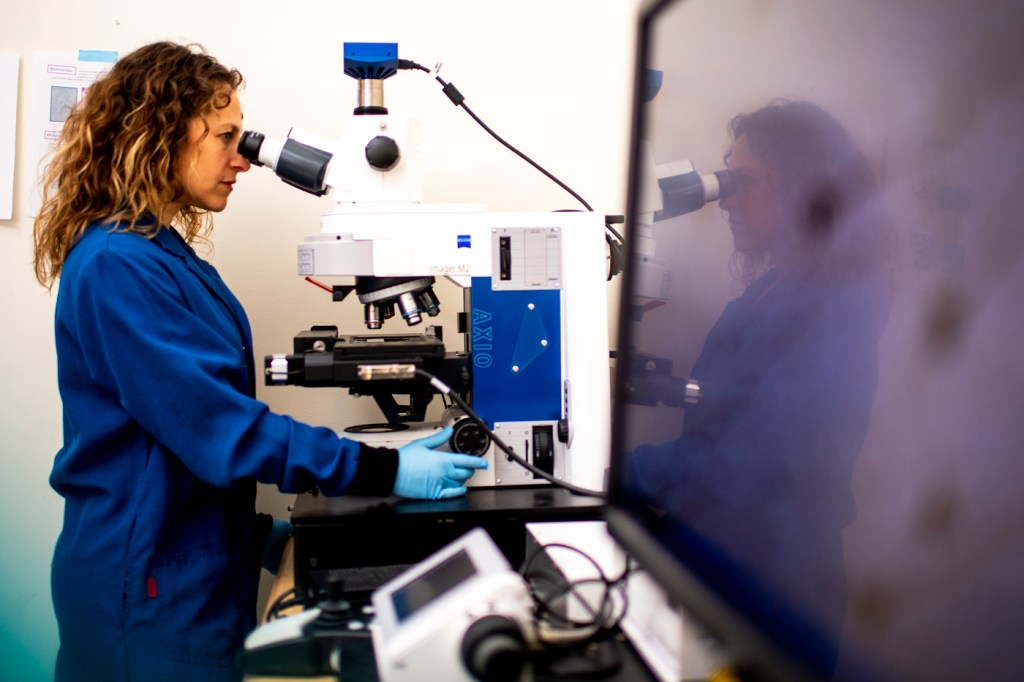

Research Offers New Ideas for Treating Alzheimer’s
“out-of-the-clump,” mitochondrial, and other theories offer hope on alzheimer’s..
Posted May 17, 2024 | Reviewed by Tyler Woods
- What Is Dementia?
- Find counselling to help with dementia
- The need for a new "out-of-the-clump" way of thinking about AD is emerging as a top priority in brain science.
- In Alzheimer’s, the brain’s immune system fails to differentiate between bacteria and brain cells.
- Probiotics may not only support a healthier gut, but a healthier brain as well.
- For the elderly, in particular those with cognitive impairment, good oral hygiene is essential.
Dementia refers to an array of symptoms characterized by failing short-term memory , confused thinking, and a decline in language skills. Of all the dementias, Alzheimer’s disease (AD) constitutes approximately 60 to 80 percent of cases.
Two drugs, Lecanemab and Donanemab, have been hailed as part of a new class of monoclonal antibody (MOA) drugs that could mark a turning point for Alzheimer’s (AZ) drug research. These drugs are incredibly expensive and carry risks of brain microbleeds and swelling. More importantly, they do not cure or even halt the disease, they delay it by about six months on average. At least 98 unique compounds tested in Phase 2 or 3 trials that pursued the various MOA classes have failed over the years. Howard Chertow, of McGill University, commented, “They’re not a home run.”
Personally, I think they’re more like a strike-out, in view of the fact that most neuroscientists and the drug companies employed by them may be looking in the wrong places in the wrong way.
In 2006, a research paper published in the highly regarded journal Nature asserted that the development of Alzheimer’s is caused by the formation in the brain of abnormally high levels of the naturally occurring protein beta-amyloid that clumps together to form plaques and the intracellular accumulations of neurofibrillary tangles of tau protein that disrupt cell function.
In 2023, a critical review in the journal Brain , collaboratively written by scientists from Denmark, the U.S., Italy, and Australia, stated that “Despite the importance of amyloid in the definition of Alzheimer's disease, we argue that the data point to Aβ playing a minor aetiological role.” They further asserted that the search for more effective ways to treat Alzheimer’s should involve more than amyloid as the single causative agent.
I propose to discuss the currently leading "out-of-the-clump" research, a term coined by Donald Weaver of the University of Toronto, that may eventually usher in new and better ways of dealing with Alzheimer’s.
One of the most auspicious of these novel directions comes from the above-mentioned Weaver, who found that significant resemblances between bacterial membranes and brain cell membranes exist. Beta-amyloid erroneously mistakes the brain cells for invading bacteria and attacks them. These brain cells gradually decay, ultimately leading to dementia. According to Weaver, Alzheimer’s is an autoimmune disease.
If this theory gains traction in the scientific world, treatments that are effective in autoimmune diseases such as celiac disease, Crohn’s disease, diabetes type 1, eczema, etc. may prove successful in the treatment of Alzheimer’s.
In addition to this autoimmune theory of Alzheimer’s, many other new and varied theories are appearing. John Mamo of Curtin University in Australia, demonstrated already in 2021 that the liver also makes amyloid protein.
It follows that finding ways to either prevent the liver from manufacturing the amyloid protein or destroying it before it enters the circulation ought to be explored.
A recent study from Portugal suggests that Alzheimer’s is a disease of the mitochondria . Mitochondria are tiny organelles (similar to organs like the heart or liver but much smaller inside cells) that generate most of the chemical energy required to power the cell's functions. The authors of this study reported positive outcomes in Alzheimer’s with animals fed a diet rich in antioxidants.
This is good news because we are in familiar territory here. We have known for a long time that antioxidants scavenge free radicals from the body cells and prevent or reduce the damage caused by oxidation. Of course, further research is necessary before it is proven that antioxidants in humans can lessen the risk of developing Alzheimer’s or benefit people in the early stages of Alzheimer’s. However, the consumption of antioxidants like vitamins A, C, and E, the minerals copper, zinc, and selenium, as well as nuts, fruits and vegetables, pecans, blueberries, and dark chocolate, seems well-proven to benefit the health of everyone, at any stage of life.
Scientists from the University of Bern, Switzerland, contend that Alzheimer’s is the end result of a brain infection, particularly with bacteria from the mouth. Since our hands and fingers swarm with viruses and bacteria, a recent paper that advanced the hypothesis that nose picking could play a role in increasing the risk of developing Alzheimer’s makes much sense. Digging around our noses is encouraging all those little critters to hop on the olfactory nerve train and take a vacation in our brains.
Recent research has focussed on probiotics as potentially beneficial in preventing the development or slowing the progression of Alzheimer’s. Probiotics are foods or supplements that contain live microorganisms that help to maintain or improve a diverse microflora in the gut. A systematic review of the literature on the effect of probiotics on Alzheimer’s by scientists from Malaysia in conjunction with researchers from Baghdad in 2022 write, “Probiotics are known to be one of the best preventative measures against cognitive decline in AD. Numerous in vivo trials and recent clinical trials have proven the effectiveness of selected bacterial strains in slowing down the progression of AD. It is proven that probiotics modulate the inflammatory process, counteract [with] oxidative stress , and modify gut microbiota.”

This and many other academic papers present robust evidence on the role of probiotics in alleviating the progression of Alzheimer’s.
As opposed to drugs, probiotics are readily available in foods such as yogurt, buttermilk, sauerkraut, pickles, and many others.
If we are going to make significant advances in the prevention and treatment of Alzheimer’s, we urgently require new approaches outside the old amyloid plaque box. Here I reviewed a number of such studies that promise to make a difference in the near future.
Understanding the condition, its origins, and effective strategies for prevention should be a top priority of our healthcare system.
Lee, Y. R., Ong, L., Gold, M., Kalali, A., & Sarkar, J. (2022). Alzheimer’s disease: key insights from two decades of clinical trial failures. Journal of Alzheimer's Disease, 87(1), 83-100.
Van Dyck, C. H., Swanson, C. J., Aisen, P., Bateman, R. J., Chen, C., Gee, M., ... & Iwatsubo, T. (2023). Lecanemab in early Alzheimer’s disease. New England Journal of Medicine, 388(1), 9-21.
Romanenko, M., Kholin, V., Koliada, A., & Vaiserman, A. (2021). Nutrition, gut microbiota, and Alzheimer's disease. Frontiers in psychiatry, 12, 712673
Prater, K. E., Green, K. J., Smith, C. L., ... & Jayadev, S. (2023). Human microglia show unique transcriptional changes in Alzheimer’s disease. Nature Aging, 3(7), 894-907.

Thomas R. Verny, M.D. , the author of eight books, including The Embodied Mind , has taught at Harvard University, University of Toronto, York University, and St. Mary’s University of Minnesota. His podcast, Pushing Boundaries , may be viewed on Youtube or listened to on Spotify and many other platforms.
- Find a Therapist
- Find a Treatment Center
- Find a Psychiatrist
- Find a Support Group
- Find Online Therapy
- International
- New Zealand
- South Africa
- Switzerland
- Asperger's
- Bipolar Disorder
- Chronic Pain
- Eating Disorders
- Passive Aggression
- Personality
- Goal Setting
- Positive Psychology
- Stopping Smoking
- Low Sexual Desire
- Relationships
- Child Development
- Therapy Center NEW
- Diagnosis Dictionary
- Types of Therapy

At any moment, someone’s aggravating behavior or our own bad luck can set us off on an emotional spiral that threatens to derail our entire day. Here’s how we can face our triggers with less reactivity so that we can get on with our lives.
- Emotional Intelligence
- Gaslighting
- Affective Forecasting
- Neuroscience

IMAGES
COMMENTS
The Alzheimer's disease-polygenic risk scores (AD-PRS) approach did not show any significant impact on cognition. ... New research finds no causal link between vitamin E levels and osteoarthritis.
Credit: Pixabay/CC0 Public Domain. Alzheimer's Disease can be detected years in advance of a clinical diagnosis by monitoring how people manage their finances, according to new research. Using AI ...
Researchers have discovered a new avenue of cell death in Alzheimer's disease and vascular dementia. A new study, led by scientists at Oregon Health & Science University and published online in the journal Annals of Neurology on Aug. 21, reveals for the first time that a form of cell death known as ferroptosis — caused by a buildup of iron in cells — destroys microglia cells, a type of ...
An MRI of a brain of a person with Alzheimer's disease. A new study suggests having two copies of a genetic variant called APOE4 is a cause of the disease, not just a risk factor for it.
Anne Trafton. June 27, 2023. A pair of structures in the hypothalamus called the mammillary bodies (highlighted in green) are among the first brain regions to show neurodegeneration in Alzheimer ...
Early clinical trials of gamma-wave treatments have shown dramatic results. In 2016, Tsai and Boyden were scientific co-founders of Cognito Therapeutics, a startup that has raised $93 million to commercialize gamma-wave technology. In July 2023, Cognito reported positive preliminary results for a phase 2 trial of its proprietary goggle-like ...
Scientists discover new cause of Alzheimer's, vascular dementia. 1. Feedback to editors. Scientists at Oregon Health and Science University have made a development that could lead to a greater ...
Researchers say we appear to be at the start of a new era for Alzheimer's treatment. Trial results published in January showed that for the first time a drug has been able to slow the cognitive decline characteristic of the disease. The drug, lecanemab, is a monoclonal antibody that works by binding to a key protein linked to the malady ...
The research team — located at Emory University School of Medicine, part of the Accelerating Medicines Partnership® Program for Alzheimer's Disease (AMP®-AD) Consortium — used advanced automated techniques to compare the levels of both proteins and RNA molecules in more than 1,000 brain tissue samples. The samples came from the ...
Meta-analysis of genome-wide association studies on Alzheimer's disease and related dementias identifies new loci and enables generation of a new genetic risk score associated with the risk of ...
Regular walks strengthen connections in and between brain networks, according to new research, adding to growing evidence linking exercise with slowing the onset of Alzheimer's disease. The study ...
Research sheds light on how proteins linked to Alzheimer's disease influence neuronal growth. ScienceDaily . Retrieved May 15, 2024 from www.sciencedaily.com / releases / 2024 / 05 / 240515122837.htm
November 8, 2022. Alzheimer's Disease. NIH has released Advancing Alzheimer's Disease and Related Dementias Research for All Populations: Prevent. Diagnose. Treat. Care. (PDF, 17M), a 2022 scientific progress report. The report features science advances and related efforts made between March 2021 and early 2022 in areas including drug ...
New data confirm that APOE4 homozygosity is a major genetic cause of Alzheimer's disease, warranting the development of specialized research strategies, treatment approaches and clinical trials.
A new Alzheimer's drug slowed cognitive decline by 35%, according to late-stage trial results, raising the prospect of a second effective treatment for the disease. Donanemab met all goals of ...
Learn about Alzheimer's Disease symptoms such as memory loss and senile dementia. ... 2024 — New research has shed light in the complex ... Study Finds Strongest Evidence to Date of Brain's ...
New findings from big-data and open-science research are revealing clues about the molecular mechanisms of Alzheimer's disease and new ways to discover potential therapeutic targets and biomarkers. These new discoveries were made by six research teams participating in the Accelerating Medicines Partnership Alzheimer's Disease (AMP AD) program.
How a mutation in microglia elevates Alzheimer's risk. A new study finds that microglia with mutant TREM2 protein reduce brain circuit connections, promote inflammation, and contribute to Alzheimer's pathology in other ways. ... therapeutic strategies, and fundamental research to advance understanding of age-related neurodegenerative ...
Using mouse models, researchers in Australia have identified one of the likely causes of Alzheimer's disease. Some have dubbed the finding a "breakthrough.". By studying the blood-brain ...
The drug, from pharmaceutical giant Eli Lilly, was able to slow Alzheimer's disease progression by 35 per cent in patients in the earliest stages of the disease. Across the whole study, there was ...
The field of Alzheimer's research is branching out. After decades of focusing on the sticky amyloid plaques and tangled tau fibers associated with the disease, brain researchers are searching for ...
Earlier this year, brexpiprazole became the first FDA-approved treatment of agitation-associated Alzheimer's dementia. Of the 6.7 million people 65 and older in the US with Alzheimer's dementia ...
Read the latest research on Alzheimer's disease. Learn about Alzheimer's symptoms such as memory loss and senile dementia. Find out about Alzheimer's stages, causes and new treatments.
Over the last year, there have already been several therapeutics approved for slowing down the progression of Alzheimer's by about 20% to 30%. This research, if successful, could help in the development of treatments that could slow the disease even further if researchers can figure out how to disrupt the interactions causing the plaques to grow.
According to an NIA-funded study, these brain scan signatures may be combined with demographic, clinical, cognitive, and genetic information to help researchers better understand the underlying factors that influence a person's dementia, as well as improve Alzheimer's research. Results of the study were published in Alzheimer's & Dementia.
Based on the new study, researchers say the inherited form of Alzheimer's would account for 1 in 6 cases. This change came about because scientists say they better understand the role the APOE ...
As part of his reporting for "The Last Alzheimer's Patient" documentary, CNN Chief Medical Correspondent Dr. Sanjay Gupta travels to Jackson Hole, Wyoming, to learn more about an ...
New research published in Aging Cell provides insights into how exercise may help to prevent or slow cognitive decline during aging. Treatments that depleted microglia revealed that these cells ...
Dementia refers to an array of symptoms characterized by failing short-term memory, confused thinking, and a decline in language skills. Of all the dementias, Alzheimer's disease (AD ...
People who exercise have a lower risk of brain disorders such as Alzheimer's disease and depression, new research indicates.